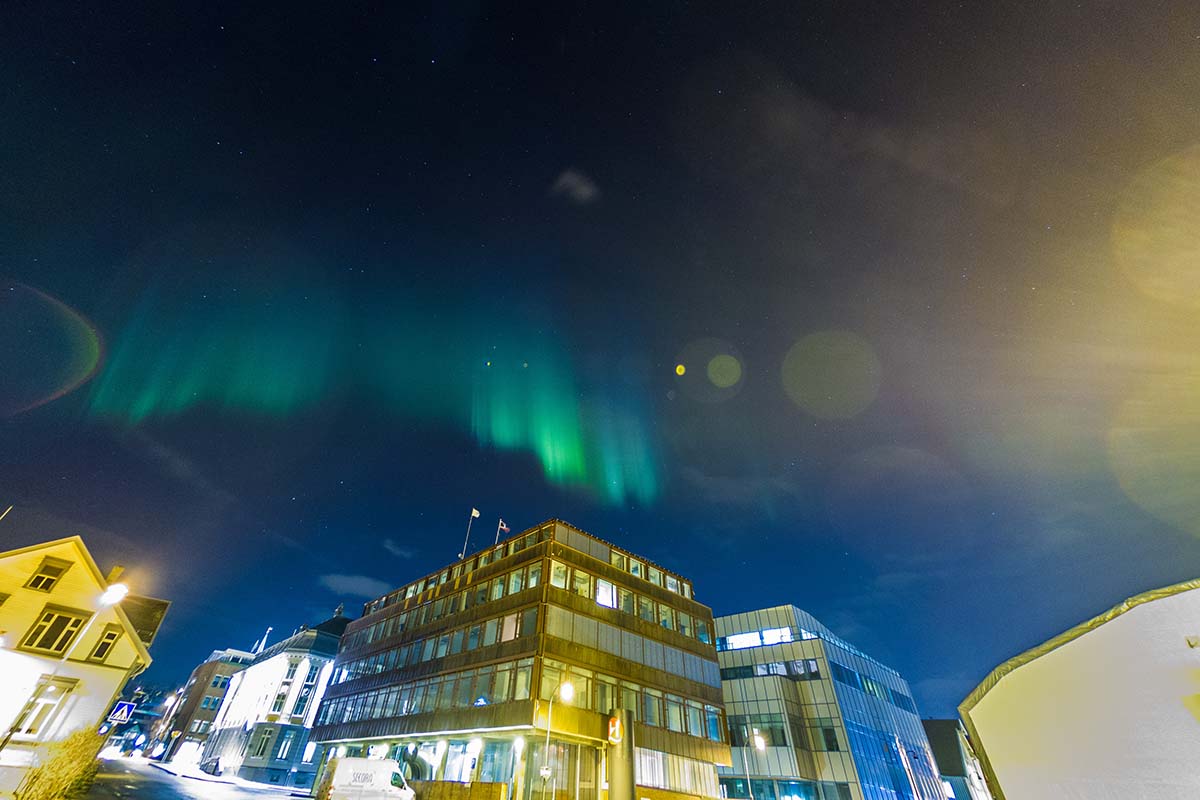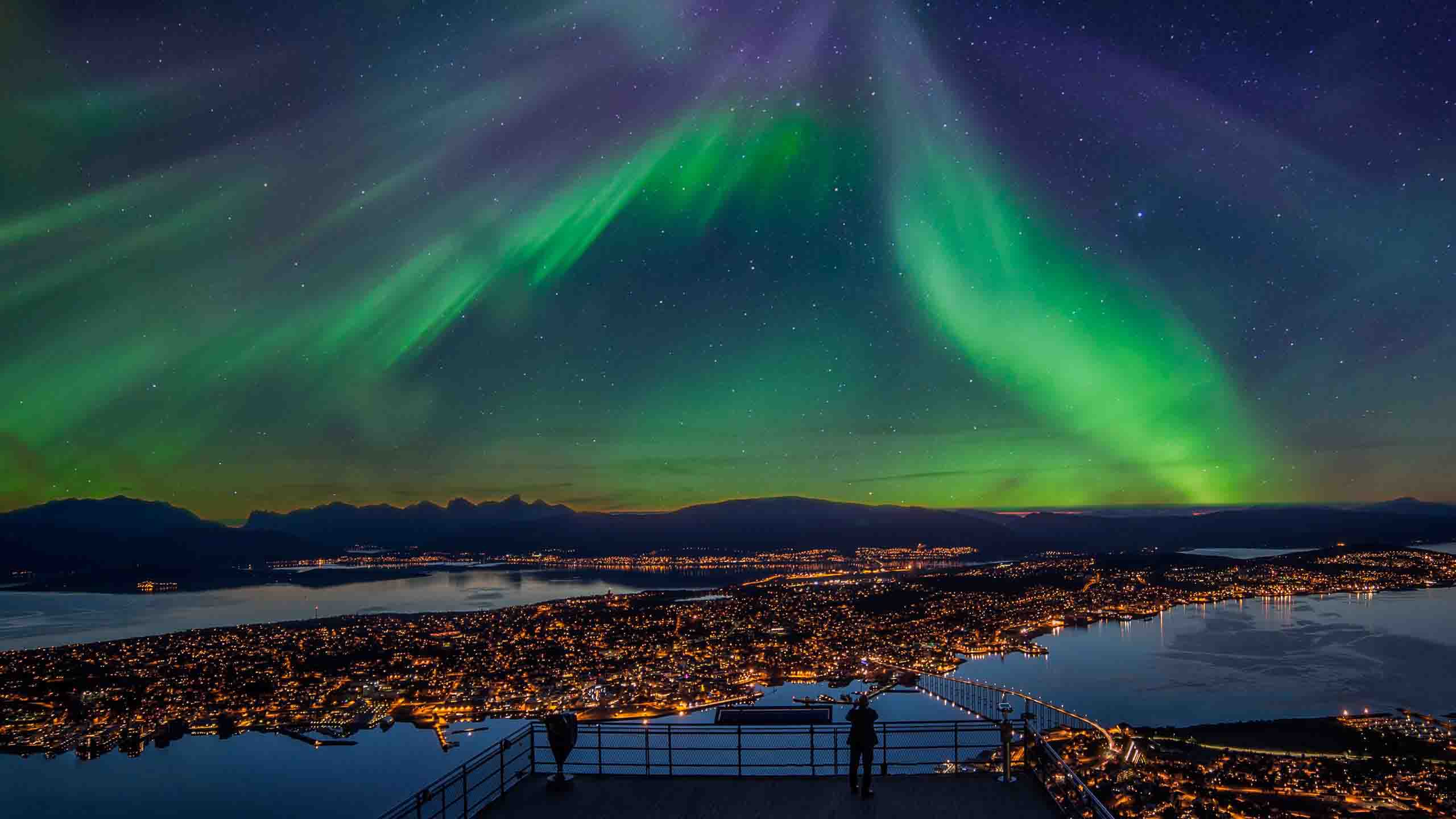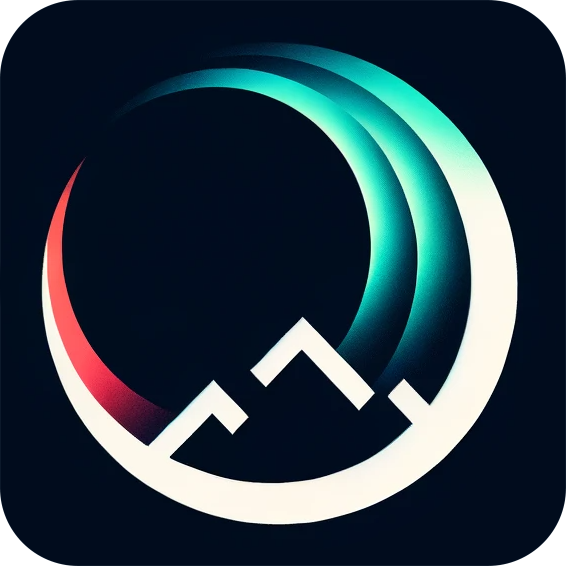The quest for the northern lights often leads adventurers to Tromsø. Situated in the heart of Norway’s Arctic region, this city on an island has become a hub for those wanting to witness the mesmerizing display of the northern lights. The Northern Lights Tromsø showcases, paint the night sky with colours and patterns, creating a spectacle that leaves a lasting impression on all who witness it.
With its favourable geographical location, Tromsø provides a front-row seat to this supernatural spectacle during the dark, clear winter nights of the Arctic.
The city not only provides a perfect theatre for the Aurora Borealis but also acts as a gateway for broader Arctic explorations. And while the northern lights are the star attraction, the adventures extend beyond the night sky into the heart of the Arctic’s pristine wilderness and Tromsø’s vibrant culture.
This guide is your compass for chasing the Northern Lights Tromsø is famous for, providing you with all the essential knowledge for a successful aurora quest.
Whether you’re an avid photographer, a nature lover, or someone seeking an adventure, the journey to chase the Northern Lights in Tromsø and beyond promises wonder and unforgettable memories.
Do you plan to watch whales when in the Arctic? Check out our guide to Tromsø whale watching
Section 1: Understanding the Northern Lights

The Northern Lights Tromsø is renowned for are not just a celestial marvel; they are a bridge to the cosmos, rooted in both science and mythology. Also known as Aurora Borealis, the lights arise from particles from the sun colliding with atoms and molecules in the Earth’s atmosphere. When these solar particles meet the atmospheric gases, they create a natural light display in the sky. The colours can range from green to pink to red to purple.
Geographically, Tromsø is located in the Aurora Zone, which is why it’s a hotspot for northern lights sightings. The Northern Lights Tromsø offers are a testament to the city’s geographical gift, providing consistent opportunities for viewing.
Historically, the northern lights have been a part of Arctic culture and folklore. In Norway, old legends say the lights are the spirits of the dead. Seeing the northern lights was often seen as a good omen. They have also been a source of inspiration for numerous Nordic myths. As everyone who grew up in the Arctic will let you know, never point, whistle or wave at the northern lights. You risk that the northern light will come down and take you away!
Section 2: Best Time and Locations for Northern Lights in Tromsø

Witnessing the northern lights is a time-sensitive endeavour. The ideal months to catch this show in Tromsø span from late September to early April. During this period, the nights are long and dark, creating the perfect canvas for the Aurora Borealis.
The weather is the main factor in the visibility of the northern lights. Clear skies are your best friend when it comes to Aurora chasing, and Tromsø, despite its snowy reputation, has many clear nights in winter. And if it’s cloudy around the island itself, there are places in the region that often offer clear skies even when it’s snowing nearby.
Polar nights are a real thing so far above the Arctic Circle, and daylight hours are scarce during the winter months. In December and January, the sun doesn’t rise above the horizon at all. This extended darkness increases the chances of seeing the northern lights.
Northern Lights Tromsø: The best spots for Aurora viewing:
Without a car
Tromsø Island
The city itself offers decent spots to view the Aurora. However, light pollution can interfere with the experience. Luckily, at the top of the island, you find a small lake known as Prestvannet. There is much less artificial light in the area surrounding the pond, and there are a few great spots for Aurora-watching. You can get to the pond by bus or even by walking from the city centre, it’s a 25-minute walk.
Take care and check with local experts before walking out on the frozen lake as the ice might not be safe.
Telegrafbukta at the southern tip of Tromsø Island is also a decent area to get away from the light pollution of the city centre. It’s easily accessible by bus.
With a car
Kvaløya (Whale Island)
Just a short drive from Tromsø, this large island offers numerous spots with little to no light pollution, making it an ideal location for Aurora chasing.
Ersfjordbotn
A small village on Kvaløya, located about a 30-minute drive from Tromsø. Known for its dramatic fjord scenery which makes for a stunning backdrop to the dancing lights.
Sommarøy
An island a bit further out from Tromsø, about a 60-minute drive, known for its beautiful beaches and clear skies, offering a unique seaside vantage point for Aurora viewing. There will be plenty of good spots on the drive to Sommarøy as well.
Each of these locations offers a unique backdrop for viewing the northern lights Tromsø is famed for. It’s worth exploring multiple spots if time allows, to fully appreciate the variety of experiences Tromsø and its surroundings offer for Aurora viewing.
Lastly, remember to dress warmly, as temperatures can plummet during the night, and conditions can change rapidly in the Arctic.
Tours or self-guided?
Venturing to see the northern lights can be a thrilling experience, whether you choose to join a guided tour or embark on a self-guided expedition. Both options have their merits, and the choice largely depends on personal preferences and circumstances.
Guided Tours
Guided tours provide a hassle-free way to chase the northern lights. They usually include transportation, professional guides with local knowledge, and sometimes refreshments or meals.
Pros:
- Expert guidance ensures you are taken to the best viewing spots based on current weather conditions.
- Equipment such as tripods or thermal suits may be provided.
- Informative commentary enhances understanding of the phenomenon.
- Social interaction with other travellers.
Cons:
- Can be more expensive than self-guided expeditions.
- Less flexibility in terms of locations and timing.
- Potential for crowded viewing spots.
Self-Guided
On the other hand, a self-guided expedition offers more flexibility — but requires more preparation.
Pros:
- Freedom to find and choose viewing spots and stay as long as you wish.
- Opportunity for a more personal, solitary experience.
- Generally more cost-effective.
Cons:
- Requires thorough preparation including understanding of local weather conditions and suitable viewing spots.
- Lack of professional guidance may result in missed viewing opportunities.
- Necessary to have your own transportation and equipment.
- Inexperienced drivers may find snowy and icy conditions in Tromsø challenging. However, if you take it slow and drive carefully you shouldn’t be scared away from driving yourself.
Tour Operator Recommendations:
Several reputable tour operators offer well-organised northern lights tours in and around Tromsø. Here are a few recommendations:
1. Best Arctic: Offers a variety of northern lights tours including bus tours, boat cruises, and photography tours.
2. Chasing Lights: Known for their enthusiastic guides and photography-focused tours.
3. Tromsø Arctic Reindeer: Provides a unique experience combining reindeer sledging with northern lights chasing.
4. NorthernShots Tours: Offers photography-centric tours with professional photographers to help capture the moment.
5. Aurora Borealis Tromsø: Known for their knowledgeable guides and a variety of tour options.
Each of these operators provides a unique perspective and experience when it comes to chasing the northern lights in Tromsø and beyond.
Section 3: Tips for a Self-Guided Northern Lights Trip

A self-guided Northern Lights trip can be an exciting adventure. Here are some tips to ensure you are well-prepared for this journey:
Preparations:
- Forecasts: Check the weather and Aurora forecasts frequently. The best app for weather forecasts in Norway is Yr. They also have an Aurora forecast. If you want more advanced Aurora Forecast you can check out the app Aurora Forecast which includes a paid option.
- Locations: Research and list down the best spots with little to no light pollution. Popular spots include Ersfjordbotn and Sommarøy.
- Timings: The best time to see the northern lights is between 6 pm to 4 am, although they can appear anytime during dark hours.
Gear:
- Clothing: Dress warmly in layers. Include thermal undergarments, preferably wool, a windproof coat, warm boots with wool socks, gloves, and a hat.
- Photography Equipment:
- Camera: A camera with manual settings to adjust ISO, shutter speed, and aperture is crucial.
- Tripod: A sturdy tripod to keep the camera stable during long exposures.
- Extra Batteries: Cold temperatures can drain battery life quickly, so having spares is advisable.
- Lens Warmer: To prevent lens fogging.
- Mobile charger: Your phone will most likely be your navigation system, so remember spare powerbanks and a cable to keep your phone topped up. Remember the battery drains quickly in the cold.
- Snacks and Hot Drinks: Pack some hot drinks in a thermos and some snacks to keep you energised.
- A Torch or Headlamp: Preferably with a red light to preserve night vision.
- Portable Chairs and Blankets: To stay comfortable while waiting for the lights to appear.
- A high visibility vest: Take care when you stop along roads, and always wear a high-visibility vest when exiting the car along the road.
Thorough preparation and the right gear can significantly enhance your self-guided Tromsø Northern Lights trip. It ensures not only a higher chance of seeing the Aurora Borealis but also a comfortable and safe experience as you venture into the chilly Arctic nights.
Section 4: Capturing the Aurora: Photography Tips

Capturing the Northern Lights requires a blend of the right equipment, technical settings, and patience. Here’s how you can go about it:
Camera Settings and Gear:
1. Camera: A DSLR or a mirrorless camera with manual settings is ideal. You should be able to adjust the ISO, shutter speed, and aperture.
2. Lens: A fast wide-angle lens (f/2.8 or faster) is preferred as it captures a broader view and allows more light to hit the sensor.
3. Tripod: A sturdy tripod is crucial to eliminate camera shake during long exposures.
4. Remote Shutter Release: This accessory further helps in reducing camera shake while triggering the shutter.
Settings:
1. Focus: Set your lens to infinity focus (∞), but ensure that everything is sharp in a test photo.
2. Aperture: Use a wide aperture (low f-number) to allow as much light in as possible, typically f/2.8 or wider.
3. Shutter Speed: Start with a shutter speed of about 10-20 seconds; adjust as needed depending on the movement and brightness of the aurora.
4. ISO: Begin with an ISO setting of 800-1600 and adjust to achieve the desired exposure.
Composition Tips for Stunning Aurora Photographs:
1. Foreground Interest: Include interesting elements in the foreground such as silhouetted trees, reflections on water, or snow-covered rocks to add depth to your images.
2. Leading Lines: Use natural or man-made lines like roads or rivers to lead the viewer’s eye towards the aurora.
3. Reflections: If near water, utilise reflections to double the visual impact of the aurora.
4. Experiment: Don’t hesitate to experiment with different angles, settings, and compositions to find what works best.
5. Patience: Aurora photography requires patience. Wait for the right moment when the aurora is active, and the sky is clear.
With the right gear, settings, and composition, you can capture stunning photographs of the northern lights Tromso is famous for, creating lasting memories of your Arctic adventure.
Capturing the Aurora on a Phone:
In recent years, smartphone cameras have vastly improved, and some are capable of capturing the Northern Lights, albeit not as clearly as a DSLR or mirrorless camera.
If a smartphone is what you have, ensure it’s one with a manual or pro mode where you can adjust settings. Set your phone on a sturdy tripod to avoid any shake, as you’ll need a long exposure.
Adjust the ISO to a lower setting to reduce noise, and set the shutter speed to around 10 to 15 seconds to start. It’s essential to find a spot with minimal light pollution, and a clear, cloudless sky will significantly enhance your chances of capturing the Aurora on your phone.
Some apps are designed to help with low-light and long-exposure photography, which can be beneficial. While the results may not be as high-quality as with a more advanced camera, with patience and the right conditions, you can still capture a memorable image of the Northern Lights in Tromsø on your smartphone.
Section 5: Safety Considerations
Embarking on nighttime excursions in the remote, chilly realms of Tromsø in pursuit of the Northern Lights requires a significant emphasis on safety.
Dressing in warm, layered clothing, having a well-charged phone, and informing someone about your whereabouts are crucial steps. Travelling with a companion or group is advisable for enhanced safety. Additionally, respecting the local communities and the pristine Arctic environment is paramount.
Following local guidelines, reducing noise levels, and ensuring no litter is left behind are ways to show respect and ensure the continued beauty and accessibility of these stunning locations for future aurora chasers.
Section 6: Beyond the Lights: Other Arctic Attractions
This town is not only a gateway to the mesmerizing Northern Light Tromsø displays but also a hub of cultural vibrancy. Even when the clouds are thick and the Aurora is nowhere to be seen you can immerse yourself in a variety of experiences.
Tromsø is a town with interesting museums as well as a great restaurant scene and nightlife. Just outside town, you can explore whale watching, the indigenous Sámi culture, dog sledging or snowmobiling. Check out our guide to the best restaurants in town here.
Conclusion
Chasing the Northern Lights in Tromsø is an awe-inspiring adventure that leaves unforgettable memories. The beauty of the aurora, coupled with the Arctic landscape, offers a surreal experience. This guide aims to provide a comprehensive pathway for those keen on embarking on the chase, ensuring a safe and enriching journey.
The beauty of Tromsø and the broader Arctic extends beyond the night sky, and there’s a rich tapestry of experiences awaiting those who venture to explore it.

[…] out our comprehensive guide to the Northern […]